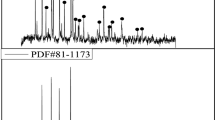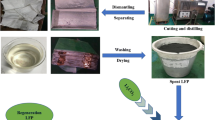Abstract
Valuable metals have been efficiently recovered from spent lithium iron phosphate batteries by employing a process involving via iron sulfate roasting, selective leaching, and stepwise chemical precipitation. This study proposes the selective extraction of lithium from LiFePO4 using the iron sulfate roasting-leaching method. The roasting process parameters were optimized, and the optimum roasting parameters were: Fe2(SO4)3/LiFePO4 molar ratio of 1:2, roasting temperature of 450 °C, roasting time of 5 h, at this time, the leaching rate of Li can reach 98.53%. Fe was separated using the NaOH + H2O2 system by controlling the pH, and FePO4 was recovered using the precipitation method. The mother liquor was concentrated and maintained at a temperature of approximately 90 °C, and then a saturated sodium carbonate solution was added to precipitate Li2CO3. The recovery of Li was 82%, and the purity of Li2CO3 was approximately 95%.
Graphical Abstract




















Similar content being viewed by others
References
Zhu X, Ren M, Wu G et al (2019) Promoting new energy vehicles consumption: the effect of implementing carbon regulation on automobile industry in China. Comput Ind Eng 135:211–226
Qiankun J, Jialiang Z, Yubo L et al (2020) Direct regeneration of spent LiFePO4 cathode material by a green and efficient one-step hydrothermal method. ACS Sustain Chem Eng 8(48):17622–17628
Wen-bo L, Yang Z, Ying Z et al (2021) A facile way to regenerate FePO4∙2H2O precursor from spent lithium iron phosphate cathode powder: spontaneous precipitation and phase transformation in an acidic medium. J Alloys Compd 856:158148
Hao J, Zhang J, Wang D et al (2022) Facile and efficient recovery of lithium from spent LiFePO4 batteries via air oxidation—water leaching at room temperature. Green Chem 24(1):152–162
Tang X, Li P, Yang F et al (2018) Research progress on hydrometallurgical recovery of spent lithium iron phosphate. Nonferr Met (Extr Metall) 10:54–59
Li X, Zhang J, Song D et al (2017) Direct regeneration of recycled cathode material mixture from scrapped LiFePO4 batteries. J Power Sources 345:78–84
Yuesheng W, Shi-Ze Y, Ya Y et al (2018) High-capacity and long-cycle life aqueous rechargeable lithium-ion battery with the FePO4 anode. ACS Appl Mater Interface 10(8):7061–7068
Xiao L, Li L, Fu F et al (2012) Studies on non-isothermal and isothermal dehydration kinetics of FePO4.2H2O. Thermochim Acta 541:57–61
Yang C, Zhang J, Jing Q et al (2021) Recovery and regeneration of LiFePO4 from spent lithium-ion batteries via a novel pretreatment process. Int J Miner Metall Mater 28(09):1478–1487
Zhang X, Xue Q, Li L (2016) Sustainable recycling and regeneration of cathode scraps from industrial production of lithium-ion batteries. ACS Sustain Chem Eng 4(12):7041–7049
Xu X, Mi J, Fan M et al (2019) Study on the performance evaluation and echelon utilization of retired LiFePO4 power battery for smart grid. J Clean Prod 213:1080–1086
Xiao-Hui Y, Cong-Cong Z, Wan-Bing Z et al (2021) Recycling phosphorus from spent LiFePO4 battery for multifunctional slow-release fertilizer preparation and simultaneous recovery of lithium. Chem Eng J 426:131311
Qiao D, Wang G, Gao T et al (2020) Potential impact of the end-of-life batteries recycling of electric vehicles on lithium demand in China: 2010–2050. Sci Total Environ 764:142835
Wang W, Wu Y (2017) An overview of recycling and treatment of spent LiFePO4 batteries in China. Resour Conserv Recycl 127:233–243
Zheng Y, Liu Y, Dong C et al (2014) Research status of spent lithium iron phosphate battery recycling. Chin J Power Sources 38(06):1172–1175
Castillo S et al (2002) Advances in the recovering of spent lithium bakery compounds. J Power Sources 112(1):247–254
Wu F (2004) Recovery of cobalt and lithium from spent lithium-ion secondary batteries. Chin J Nonferr Met 4:697–701
Zhejiang University (2012) A method for recovering and preparing lithium iron phosphate from waste lithium iron phosphate battery: China. Zhejiang University
Dai C et al (2012) Recycling method of waste lithium iron phosphate battery: China.
Dong C et al (2019) Recycling and regeneration of LiFePO4 from spent lithium ion batteries. Chin J Power Sources 43(02):201–203+240
Sun M et al (2019) Study on recovery of valuable metals from spent lithium-ion batteries. Nonferr Met (Extr Metall) 3:68–72
Zhang X, Wang H, Li Z et al (2022) New process of sulfated-water leaching for treating electrode material of spent lithium iron phosphate batteries. Energy Storage Sci Technol 11(07):2066–2074
Gengenbach TR, Chatelier RC et al (1996) Characterization of the ageing of plasma-deposited polymer films: global analysis of X-ray photoelectron spectroscopy data. Surf Interface Anal 24(4):271–281
Larachi F et al (2002) Ce3d XPS study of composite CexMn1−xO2−y wet oxidation catalysts. Appl Surf Sci 195(1–4):236–250
Acknowledgements
This paper was supervised by Liu Qingsheng throughout the experiment and writing processes. Teacher Liu provided guidance and support by inquiring about the research process, identifying areas of confusion, and stimulating new ideas. I am grateful for his valuable assistance.
Funding
This study was funded by the National Key R&D Plan for the 13th Five Year Plan (2018YFC1903405).
Author information
Authors and Affiliations
Contributions
Corresponding author: Among the authors in the list, teacher QL as the cooperation teacher of this study, who provided guidance and support by inquiring about the research process, identifying areas of confusion, and stimulating new ideas. First author: This paper was written by QW, she independently completed the study design and data analysis, and took the lead in writing the paper.
Corresponding author
Ethics declarations
Conflict of interest
The authors declare no conflict of interest.
Additional information
The contributing editor for this article was Nikhil Dhawan.
Publisher's Note
Springer Nature remains neutral with regard to jurisdictional claims in published maps and institutional affiliations.
Rights and permissions
Springer Nature or its licensor (e.g. a society or other partner) holds exclusive rights to this article under a publishing agreement with the author(s) or other rightsholder(s); author self-archiving of the accepted manuscript version of this article is solely governed by the terms of such publishing agreement and applicable law.
About this article
Cite this article
Wen, Q., Liu, Qs. Recycling of Spent LiFePO4 Battery by Iron Sulfate Roasting-Leaching Method. J. Sustain. Metall. 9, 1679–1690 (2023). https://doi.org/10.1007/s40831-023-00757-3
Received:
Accepted:
Published:
Issue Date:
DOI: https://doi.org/10.1007/s40831-023-00757-3




